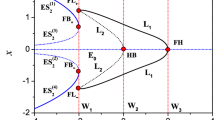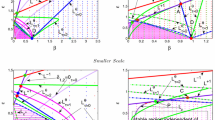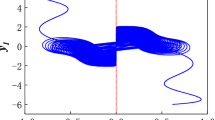Abstract
We investigate the nonlinear dynamics of a two-dimensional self-sustained oscillator subject to a delayed feedback by performing a phase reduction analysis and considering two cases of amplitude variations, which represent weakly and strongly nonlinear cases. We investigate the amplitude death phenomenon and show that the feedback phase takes a relevant role to the suppression of the oscillations when amplitude variations are taking into account. In particular, we show that amplitude death can only occur in certain ranges of the feedback phase, in which destructive interferences are more pronounced. We analytically compute codimension-one and codimension-two bifurcations of the steady states and show parameter space maps with the number of steady-state solutions. We pay an special attention to the feedback phase in antiphase configuration, in which a richer bifurcation scenario is observed. We also numerically compute basins of attraction for the investigated delayed-feedback models, which is a challenge task for time-delay systems, shedding some light to the domains of initial conditions leading to each stable phase-locked state. Finally, we briefly discuss the effects of the shear parameter, which describes the amplitude-phase coupling, in the models in which amplitude variations are taking into account.














Similar content being viewed by others
References
T. Erneux, Applied Delay Differential Equations (Springer, New York, 2009)
R. Sipahi, S. Niculescu, C.T. Abdallah, W. Michiels, K. Gu, Stability and Stabilization of Systems with Time Delay. IEEE Cont. Syst. Magazine 31(1), 38–65 (2011)
M. Lakshmanan, D. Senthilkumar, Dynamics of Nonlinear Time-Delay Systems (Springer, Berlin, 2010)
F.M. Atay, Complex Time-Delay Systems (Springer, Berlin, 2010)
R. Lang, K. Kobayashi, External optical feedback effects on semiconductor injection laser properties. IEEE J. Quant. Elect. 16(3), 347–355 (1980)
K. Ikeda, K. Kondo, O. Akimoto, Successive Higher-Harmonic Bifurcations in Systems with Delayed Feedback. Phys. Rev. Lett. 49, 1467–1470 (1982)
E.C. Zimmermann, M. Schell, J. Ross, Stabilization of unstable states and oscillatory phenomena in an illuminated thermochemical system: Theory and experiment. J. Chem. Phys. 81(3), 1327–1336 (1984)
D.V.R. Reddy, A. Sen, G.L. Johnston, Dynamics of a limit cycle oscillator under time delayed linear and nonlinear feedbacks. Physica D: Nonlinear Phenomena 144(3), 335–357 (2000)
A.G. Vladimirov, D. Turaev, Model for passive mode locking in semiconductor lasers. Phys. Rev. A 72, (2005)
S. Yanchuk, G. Giacomelli, Pattern Formation in Systems with Multiple Delayed Feedbacks. Phys. Rev. Lett. 112, 174103 (2014)
A. Keane, B. Krauskopf, C.M. Postlethwaite, Climate models with delay differential equations. Chaos: An Interdisciplinary J Nonlinear Sci 27(11), 114309 (2017)
J.W. Wu, H.B. Bao, Nonlinear Dynamics in Semiconductor Quantum Dot Laser Subject to Double Delayed Feedback: Numerical Analysis. Braz. J. Phys. 50, 594–601 (2020)
H.G. Schuster, P. Wagner, Mutual Entrainment of Two Limit Cycle Oscillators with Time Delayed Coupling. Prog. Theor. Phys. 81, 939 (1989)
J. Weiner, R. Holz, F.W. Schneider, K. Bar-Eli, Mutually coupled oscillators with time delay. J. Phys. Chem. 96(22), 8915–8919 (1992)
M. Dhamala, V.K. Jirsa, M. Ding, Enhancement of Neural Synchrony by Time Delay. Phys. Rev. Lett. 92, 074104 (2004)
A.S. Landsman, I.B. Schwartz, Complete chaotic synchronization in mutually coupled time-delay systems. Phys. Rev. E 75, (2007)
O.D Huys, R. Vicente, J. Danckaert, I, Fischer, Amplitude and phase effects on the synchronization of delay-coupled oscillators. Chaos: An Interdisciplinary J. Nonlinear Sci. 20(4), 043127 (2010)
C. Bonatto, B. Kelleher, G. Huyet, S.P. Hegarty, Transition from unidirectional to delayed bidirectional coupling in optically coupled semiconductor lasers. Phys. Rev. E 85, (2012)
T. Erneux, D. Lenstra, Synchronization of Mutually Delay-Coupled Quantum Cascade Lasers with Distinct Pump Strengths. Photonics 6(4), 125 (2019)
E. Niebur, H. G. Schuster, D. M. Kammen. Collective frequencies and metastability in networks of limit-cycle oscillators with time delay. Phys. Rev. Lett. 67, 2753–2756 (1991)
U. Ernst, K. Pawelzik, T. Geisel, Synchronization Induced by Temporal Delays in Pulse-Coupled Oscillators. Phys. Rev. Lett. 74, 1570–1573 (1995)
M.K.S. Yeung, S.H. Strogatz, Time Delay in the Kuramoto Model of Coupled Oscillators. Phys. Rev. Lett. 82, 648–651 (1999)
F.M. Atay, J. Jost, A. Wende, Delays, Connection Topology, and Synchronization of Coupled Chaotic Maps. Phys. Rev. Lett. 92, (2004)
O.D. Huys, R. Vicente, T. Erneux, J. Danckaert, I, Fischer, Synchronization properties of network motifs: Influence of coupling delay and symmetry. Chaos: An Interdisciplinary J. Nonlinear Sci. 18(3), 037116 (2008)
A.A. Selivanov, J. Lehnert, T. Dahms, P. Hövel, A.L. Fradkov, E. Schöll, Adaptive synchronization in delay-coupled networks of Stuart-Landau oscillators. Phys. Rev. E 85, (2012)
M.C. Soriano, J. García-Ojalvo, C.R. Mirasso, I. Fischer, Complex photonics: Dynamics and applications of delay-coupled semiconductors lasers. Rev. Mod. Phys. 85, 421–470 (2013)
K. Pyragas, Continuous control of chaos by self-controlling feedback. Phys. Lett. A 170(6), 421–428 (1992)
E. Schöll, H.G. Schuster, Handbook of Chaos Control (Wiley-VCH, Weinheim, 2007)
D. Kane, A. Shore, Unlocking Dynamical Diversity: Optical Feedback Effects on Semiconductor Lasers (Wiley, London, 2005)
S. Kim, S.H. Park, C.S. Ryu, Multistability in Coupled Oscillator Systems with Time Delay. Phys. Rev. Lett. 79, 2911–2914 (1997)
D.V. Ramana Reddy, A. Sen, G.L. Johnston, Time Delay Induced Death in Coupled Limit Cycle Oscillators. Phys. Rev. Lett. 80, 5109–5112 (1998)
D.W. Sukow, T. Heil, I. Fischer, A. Gavrielides, A. Hohl-AbiChedid, W. Elsäßer, Picosecond intensity statistics of semiconductor lasers operating in the low-frequency fluctuation regime. Phys. Rev. A 60, 667–673 (1999)
C. Masoller, Anticipation in the Synchronization of Chaotic Semiconductor Lasers with Optical Feedback. Phys. Rev. Lett. 86, 2782–2785 (2001)
T. Heil, I. Fischer, W. Elsäßer, A. Gavrielides, Dynamics of Semiconductor Lasers Subject to Delayed Optical Feedback: The Short Cavity Regime. Phys. Rev. Lett. 87, (2001)
O.E. Omel’chenko, Y.L. Maistrenko, P.A. Tass, Chimera States: The Natural Link Between Coherence and Incoherence. Phys. Rev. Lett. 100, (2008)
G.C. Sethia, A. Sen, F.M. Atay, Clustered Chimera States in Delay-Coupled Oscillator Systems. Phys. Rev. Lett. 100, 144102 (2008)
B. Kelleher, C. Bonatto, P. Skoda, S.P. Hegarty, G. Huyet, Excitation regeneration in delay-coupled oscillators. Phys. Rev. E 81, (2010)
T.K.D. Peron, F.A. Rodrigues, Explosive synchronization enhanced by time-delayed coupling. Phys. Rev. E 86, (2012)
M. Marconi, J. Javaloyes, S. Barland, S. Balle, M. Giudici, Vectorial dissipative solitons in vertical-cavity surface-emitting lasers with delays. Nature Photon. 9, 450–455 (2015)
S. Yanchuk, S. Ruschel, J. Sieber, M. Wolfrum, Temporal Dissipative Solitons in Time-Delay Feedback Systems. Phys. Rev. Lett. 123, (2019)
S. Terrien, V.A. Pammi, N.G.R. Broderick, R. Braive, G. Beaudoin, I. Sagnes, B. Krauskopf, S. Barbay, Equalization of pulse timings in an excitable microlaser system with delay. Phys. Rev. Research 2, (2020)
G. Saxena, A. Prasad, R. Ramaswamy, Amplitude death: The emergence of stationarity in coupled nonlinear systems. Phys Rep 521(5), 205–228 (2012). Amplitude Death: The Emergence of Stationarity in Coupled Nonlinear Systems
A. Koseska, E. Volkov, J. Kurths, Oscillation quenching mechanisms: Amplitude vs. oscillation death. Phys Rep 531(4), 173–199 (2013). Oscillation quenching mechanisms: Amplitude vs. oscillation death
R. Herrero, M. Figueras, J. Rius, F. Pi, G. Orriols, Experimental Observation of the Amplitude Death Effect in Two Coupled Nonlinear Oscillators. Phys. Rev. Lett. 84, 5312–5315 (2000)
F.M. Atay, Distributed Delays Facilitate Amplitude Death of Coupled Oscillators. Phys. Rev. Lett. 91, (2003)
R. Dodla, A. Sen, G.L. Johnston, Phase-locked patterns and amplitude death in a ring of delay-coupled limit cycle oscillators. Phys. Rev. E 69, 056217 (2004)
K. Konishi, K. Senda, H. Kokame, Amplitude death in time-delay nonlinear oscillators coupled by diffusive connections. Phys. Rev. E 78, 056216 (2008)
A. Prasad, M. Dhamala, B.M. Adhikari, R. Ramaswamy, Amplitude death in nonlinear oscillators with nonlinear coupling. Phys. Rev. E 81, 027201 (2010)
J.M. Höfener, G.C. Sethia, T. Gross, Amplitude death in networks of delay-coupled delay oscillators. Philosophical Transactions of the Royal Society A: Mathematical, Phys Eng Sci 371(1999), 20120462 (2013)
T. Biwa, S. Tozuka, T. Yazaki, Amplitude Death in Coupled Thermoacoustic Oscillators. Phys. Rev. Applied 3, (2015)
H. Teki, K. Konishi, N. Hara, Amplitude death in a pair of one-dimensional complex Ginzburg-Landau systems coupled by diffusive connections. Phys. Rev. E 95, (2017)
S.R. Huddy, Using critical curves to compute master stability islands for amplitude death in networks of delay-coupled oscillators. Chaos: An Interdisciplinary J. Nonlinear Sci. 30(1), 013118 (2020)
S. Rakshit, B. Bera, S. Majhi, C. Hens, D. Ghosh, Basin stability measure of different steady states in coupled oscillators. Scientific Reports 7, 45909 (2017)
S. Majhi, B.K. Bera, S.K. Bhowmick, D. Ghosh, Restoration of oscillation in network of oscillators in presence of direct and indirect interactions. Phys. Lett. A 380(43), 3617–3624 (2016)
F. Atay, Van der Pol’s Oscillator Under Delayed Feedback. J. Sound Vibration 218(2), 333–339 (1998)
K. Green, Stability near threshold in a semiconductor laser subject to optical feedback: A bifurcation analysis of the Lang-Kobayashi equations. Phys. Rev. E 79, (2009)
N. Zhao, Z. Sun, W. Xu, Inducing amplitude death via pinning control. Eur. Phys. J. B 92, 179 (2019)
S. Majhi, D. Ghosh, Amplitude death and resurgence of oscillation in networks of mobile oscillators. Europhys. Lett. 118(4), 40002 (2017)
W.T. Prants, C. Bonatto, Triple point of synchronization, phase singularity, and excitability along the transition between unbounded and bounded phase oscillations in a forced nonlinear oscillator. Phys. Rev. E 103, (2021)
T. Heil, I. Fischer, W. Elsäßer, B. Krauskopf, K. Green, A. Gavrielides, Delay dynamics of semiconductor lasers with short external cavities: Bifurcation scenarios and mechanisms. Phys. Rev. E 67, (2003)
H. Erzgräber, D. Lenstra, B. Krauskopf, E. Wille, M. Peil, I. Fischer, W. Elsäer, Mutually delay-coupled semiconductor lasers: Mode bifurcation scenarios. Optics Communications 255(4), 286–296 (2005)
E. Panteley, A. Lora, A. El-Ati, Practical dynamic consensus of Stuart-Landau oscillators over heterogeneous networks. Int. J. Cont. 93(2), 261–273 (2020)
J. Doyne Farmer. Chaotic attractors of an infinite-dimensional dynamical system. Physica D: Nonlinear Phenomena 4(3), 366–393 (1982)
F. Kuwashima, I. Kitazima, H. Iwasawa, Theory of Chaotic Dynamics on Class A Laser with Optical Delayed Feedback. Japanese J Appl Phys 40, Part 1, No. 2A, 601–608 (2001)
F. Kuwashima, H. Iwasawa, Chaotic Oscillations in Single-Mode Class A Laser with Long Optical Delayed Feedback. Japanese J. Appl. Phys. 46(4A), 1526–1527 (2007)
G. Huyet, D. O’Brien, S.P. Hegarty, J.G. McInerney, A.V. Uskov, D. Bimberg, C. Ribbat, V.M. Ustinov, A.E. Zhukov, S.S. Mikhrin, A.R. Kovsh, J.K. White, K. Hinzer, A.J, SpringThorpe. Quantum dot semiconductor lasers with optical feedback. physica status solidi (a) 201(2), 345–352 (2004)
K. Ludge, Nonlinear Laser Dynamics: From Quantum Dots to Cryptography (Wiley-VHC, Weinheim, 2012)
L. Lugiato, F. Pratti, M. Brambilla, Nonlinear Optical Systems (Cambridge University Press, Cambridge, 2015)
D. Pieroux, P. Mandel, Bifurcation diagram of a complex delay-differential equation with cubic nonlinearity. Phys. Rev. E 67, 056213 (2003)
B. Lingnau, K. Shortiss, F. Dubois, F.H. Peters, B. Kelleher, Universal generation of devil’s staircases near Hopf bifurcations via modulated forcing of nonlinear systems. Phys. Rev. E 102, (2020)
C. Mayol, R. Toral, H. Wio, Modulated class A laser: stochastic resonance in a limit-cycle potential system. Eur. Phys. J. B 91, 114 (2018)
Y. Tan, S. Zhang, S. Zhang, Y. Zhang, N. Liu, Response of microchip solid-state laser to external frequency-shifted feedback and its applications. Sci. Rep. 3, 2912 (2013)
C. Bonatto, J.A.C. Gallas, Accumulation horizons and period adding in optically injected semiconductor lasers. Phys. Rev. E 75, (2007)
Acknowledgements
This study was financed in part by Coordenacao de Aperfeicoamento de Pessoal de Nivel Superior, Brazil (CAPES), Finance Code 001. F.G.P. thanks Conselho Nacional de Desenvolvimento Cientifico e Tecnologico (CNPq), Brazil, for support.
Author information
Authors and Affiliations
Corresponding author
Ethics declarations
Conflict of Interest
The authors declare no competing interests.
Additional information
Publisher’s Note
Springer Nature remains neutral with regard to jurisdictional claims in published maps and institutional affiliations.
Appendix
Appendix
A class-A laser [68] with delayed feedback is described by
where \(\tilde{A}\equiv \tilde{A}(\tilde{t})\) and \(\tilde{A}'\equiv \tilde{A}(\tilde{t}-\tilde{\tau })\) represent the value of the electric field at the actual time and the delayed time, respectively. \(\tau\) is the delay time, \(\eta\) is the feedback strength, P is the pump parameter, \(\theta\) is the feedback phase, and \(\alpha\) is the atomic detuning parameter. In the situation in which the electric field is not so large, we can approximate the first term of Eq. (45)
By expanding the term below in a series Taylor, we have at first order
By applying the earlier approximation in Eq. (46), we have
Therefore,
By using the earlier approximation in Eq. 45, we obtain
By redefining the electric field as
we obtain a new system of equations known as the cubic laser model, which is known in literature as the simplest laser model [68]
Here, in the cubic laser model given by Eq. (52), we have included the atomic detuning parameter and the delayed feedback. Rewriting Eq. (52) in terms of amplitude and phase, we have
where the variables \(a=a(t)\) and \(a'\equiv a(t-\tau )\) represent the amplitude of the electric field at the actual time and the delayed time, and \(\phi \equiv \phi (t)\) and \(\phi '\equiv \phi (t-\tau )\) represent the phase of the electric field at the actual time and the delayed time, respectively. If the feedback strength is small, the amplitude of the electric field almost does not change. Therefore, by considering \(a=1\) and neglecting amplitude variations, the laser dynamics is described by a single phase equation
Rights and permissions
About this article
Cite this article
Prants, F.G., Bonatto, C. Amplitude Death, Bifurcations, and Basins of Attraction of a Planar Self-Sustained Oscillator with Delayed Feedback. Braz J Phys 52, 39 (2022). https://doi.org/10.1007/s13538-021-01001-7
Received:
Accepted:
Published:
DOI: https://doi.org/10.1007/s13538-021-01001-7




